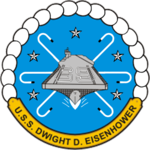This article needs additional citations for verification. (October 2008) |
 USS Dwight D. Eisenhower underway in the Atlantic Ocean
| |
| History | |
|---|---|
| Name | Dwight D. Eisenhower |
| Namesake | Dwight D. Eisenhower |
| Builder | Newport News Shipbuilding |
| Cost | $679 million ($5.3 billion in 2023 dollars) |
| Laid down | 15 August 1970 |
| Launched | 11 October 1975 |
| Sponsored by | Mamie Doud-Eisenhower[1] |
| Commissioned | 18 October 1977 |
| Renamed | from Eisenhower |
| Reclassified | CVN-69, 30 June 1975 |
| Homeport | Norfolk |
| Identification |
|
| Motto | Greater Each Day |
| Nickname(s) |
|
| Status | in active service |
| Badge |  |
| General characteristics | |
| Class and type | Nimitz-class aircraft carrier |
| Displacement | 101,600 long tons (113,800 short tons)[2][3] |
| Length |
|
| Beam |
|
| Height | 244 feet (74 m) |
| Draft |
|
| Propulsion |
|
| Speed | 30+ knots (56+ km/h; 35+ mph)[6] |
| Range | Unlimited distance; 20–25 years |
| Complement |
|
| Sensors and processing systems |
|
| Electronic warfare & decoys |
|
| Armament |
|
| Armor | Unknown |
| Aircraft carried | 90 fixed wing and helicopters |
USS Dwight D. Eisenhower (CVN-69) is a nuclear-powered aircraft carrier currently in service with the United States Navy. Commissioned in 1977, the ship is the second of ten Nimitz-class aircraft carriers currently in service, and is the first ship named after the 34th President of the United States and General of the Army, Dwight D. Eisenhower. The vessel was initially named simply as USS Eisenhower, much like the lead ship of the class, Nimitz, but the name was changed to its present form on 25 May 1970.[7] The carrier, like all others of her class, was constructed at Newport News Shipbuilding Company in Virginia, with the same design as the lead ship, although the ship has been overhauled twice to bring her up to the standards of those constructed more recently.
Since commissioning, Dwight D. Eisenhower has participated in deployments including the Gulf War in the 1990s, and more recently in support of U.S. military operations in Iraq, Afghanistan and Yemen. The carrier currently serves as the flagship of Carrier Strike Group 2.[8][9]
- ^ Polmar, Norman (2004). The Naval Institute guide to the ships and aircraft of the U.S. fleet. Naval Institute Press. p. 112. ISBN 978-1-59114-685-8. Retrieved 26 September 2016.
nimitz class displacement.
- ^ "CVN-68: NIMITZ CLASS" (PDF).
- ^ Kuperman, Alan; von Hippel, Frank (10 April 2020). "US Study of Reactor and Fuel Types to Enable Naval Reactors to Shift from HEU Fuel". International Panel on Fissile Materials. Archived from the original on 5 October 2021. Retrieved 26 February 2022.
- ^ Hanlon, Brendan Patrick (19 May 2015). Validation of the Use of Low Enriched Uranium as a Replacement for Highly Enriched Uranium in US Submarine Reactors (PDF) (MSc). Massachusetts Institute of Technology. Archived (PDF) from the original on 9 October 2021. Retrieved 26 February 2022.
- ^ Gibbons, Tony (2001). The Encyclopedia of Ships. London, United Kingdom: Amber Books. p. 444. ISBN 978-1-905704-43-9.
- ^ Evans, Mark L. (27 September 2006). "USS Dwight D. Eisenhower (CVN-69)". Dictionary of American Naval Fighting Ships. Washington, DC: Department of the Navy, Navy Historical Center. Archived from the original on 1 January 2016. Retrieved 16 January 2016.
- ^ "Useful Links". US Navy. Archived from the original on 28 September 2018. Retrieved 28 September 2018.
- ^ "USS Dwight D. Eisenhower Deploys Upon Completion of Historic COMPTUEX". United States Navy. Retrieved 3 August 2021.